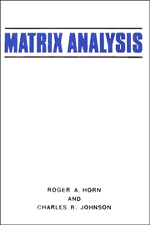Book contents
- Frontmatter
- Contents
- Preface
- Chapter 0 Review and miscellanea
- Chapter 1 Eigenvalues, eigenvectors, and similarity
- Chapter 2 Unitary equivalence and normal matrices
- Chapter 3 Canonical forms
- Chapter 4 Hermitian and symmetric matrices
- Chapter 5 Norms for vectors and matrices
- Chapter 6 Location and perturbation of eigenvalues
- Chapter 7 Positive definite matrices
- Chapter 8 Nonnegative matrices
- Appendices
- References
- Notation
- Index
Chapter 2 - Unitary equivalence and normal matrices
Published online by Cambridge University Press: 05 June 2012
- Frontmatter
- Contents
- Preface
- Chapter 0 Review and miscellanea
- Chapter 1 Eigenvalues, eigenvectors, and similarity
- Chapter 2 Unitary equivalence and normal matrices
- Chapter 3 Canonical forms
- Chapter 4 Hermitian and symmetric matrices
- Chapter 5 Norms for vectors and matrices
- Chapter 6 Location and perturbation of eigenvalues
- Chapter 7 Positive definite matrices
- Chapter 8 Nonnegative matrices
- Appendices
- References
- Notation
- Index
Summary
We next study a special type of similarity that is intimately involved with many aspects of the application of matrix analysis.
Introduction
For a general nonsingular matrix S ∈ Mn, we made an initial study of similarity via S in Chapter 1. For certain very special nonsingular matrices, called unitary matrices, the inverse of S has a simple form: S−1 = S*. Similarity of A ∈ Mn via a unitary matrix, A → S*AS, is not only conceptually simpler (S* is much easier to evaluate than S−1) than general similarity, but it has a number of attractive features that will become clearer through the development to follow. As a general rule, unitary similarities are preferable to general similarities, and it is therefore useful to know what can be achieved through unitary similarity. Equivalence classes under unitary similarity are, however, finer than under general similarity (two matrices can be similar but not unitarily similar), and correspondingly less can be achieved. For this reason, we shall return to study general similarity further in Chapter 3.
The transformation A → S*AS, A ∈ Mn, in which S is assumed to be nonsingular but not necessarily unitary, is called *congruence and will be studied in Chapter 4. This transformation, too, is an equivalence relation on Mn with a number of attractive features (different from those of similarity).
- Type
- Chapter
- Information
- Matrix Analysis , pp. 65 - 118Publisher: Cambridge University PressPrint publication year: 1985



